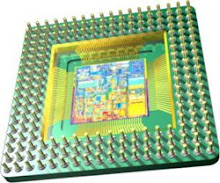

IBM today introduced a new supercomputer powered by one of the world’s fastest microprocessors and cooled by an innovative water system . The new Power 575 supercomputer, equipped with IBM’s latest POWER6 microprocessor, uses water-chilled copper plates located above each microprocessor to remove heat from the electronics. Requiring 80 percent fewer air conditioning units, the water-cooled Power 575 can reduce typical energy consumption used to cool the data center by 40 percent. IBM scientists estimate that water can be up to 4,000-times more effective in cooling computer systems than air.
With 448 processor cores per rack, the new Power 575 offers more than five times the performance of its predecessor. A single rack features 14 2U nodes, each with 32, 4.7-Ghz cores of POWER6, and 3.5 TB of memory. At 600 GFlops per node, the Power 575 is three times more energy-efficient in GFlops per kilowatt than the POWER5 generation of air-cooled processors .

